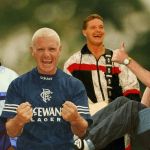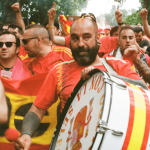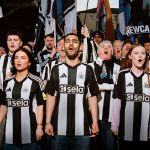
The 5 most iconic look of Paul Gascoigne
From Newcastle to Colosseum, a trip into the universe of Gazza
March 4th, 2021
After meeting Italy at the 1990 World Cup first, and exalting Lazio fans then, Paul 'Gazza' Gascoigne will return to Italy to take part in the twelfth edition of the reality show. After recently undergoing stomach surgery to end his alcohol and drug abuse, the former England footballer faces the possibility of reviving his character. Character is what Gascoigne has always been in the public eye. Not only one of the most talented players in Her Majesty's service, but above all a larger-than-life character as the English would say, a condition in which Gascoigne has been able to splash for years but at the same time has obscured its inner dramas. In this regard Gascoigne, an in-depth documentary by Jane Preston from 2015, manages to show the double face of the former Tottenham, Lazio, Rangers and Newcastle striker among others: on the one hand the success of the Sports Gascoigne and public figure, on the other the excesses and wasted opportunities of the fragile man Gascoigne, son of the working-class of the north of England.
Gascoigne’s upbringing and lifestyle have been key elements in turning the former footballer into a man of the people. The English didn’t only find in Gazza the star that had long been missing to their national team, but mostly one of them. Gazza represented the camaraderie of popular England, its innocent and maybe childish excess, its genius and recklessness. Above all, though, Gascoigne embodied the British translation of the American dream: Gazza was unique, yet everyone could be Gazza.
It is for this reason that Gascoigne became a hero when England returned home from Italia ‘90 despite coming back empty-handed. Actually, it’s Gazza’s human side that won the fans, it’s the player in tears because - after hitting the maximum amount of yellow cards - is aware that even in case of victory he’ll be missing the most important game of his career, the World Cup final.
From then on Gazza blossomed into a pop icon: poster boy, TV star, frequent face of tabloids’ front pages, and even singer. He looked like a character born in the pages of a Jonathan Coe or Irvine Welsh novel, in a condition of frail equilibrium between the ecstasy of Cool Britannia and the bitter comedowns life hits those living the suburbs framed by Danny Boyle or Ken Loach films with. By doing so - with his athletic and human highs and lows, and mostly his pranks - Gazza became the voice of a style that mirrored that of the British streetwear of the times. A style that constantly changed with the evolution of underground trends. From the ‘80s mullet to rave looks, we’ve picked five of Gascoigne’s most fascinating looks.
The Mullet
When in 1984 former world champion Jackie Charlton sits on the Newcastle bench, he immediately takes notice of the diamond in the rough Paul Gascoigne is. It’s the Eighties, Gazza is a teenager with a bright future ahead and with a few extra kilograms, and every respectable footballer or pop star sports a mullet. Charlton gives an ultimatum to the young talent: two weeks to drastically change the daily diet made of fish and chips, Coke and Minstrels chocolate. The outcome? Gazza loses weight, but not his mullet, becoming the star of the Magpies’ youth team, with whom he lifts the 1985 FA Youth Cup. The next day Gazza will join the first squad and, from then on, the rest is history.
Grand Master Gazza
In the summer of 1990, at the height of the Gazza-mania, the footballer even re-invents himself as a B-Boy, recording two singles for Best Records. With a hip-hop edge and themes revolving around life in Newcastle – like the fog on the River Tyne and the Geordie youth – the songs capture Gascoigne as an icon transversal to multiple social classes. He is a man able to unite the North and the South of England without never compromising on his provincial authenticity. If in the very same years Nike is busy launching one of the biggest sports marketing campaigns ever with the uber-serious and competitive Michael Jordan, the English seem to be doing the same, but without taking themselves too seriously. Gazza becomes the testimonial for streetwear brand RIP, whose tracksuits are worn by the player on the sleeves to his records, on his Top of the Pops performance, and even in court; contributing to the full acceptance of tracksuits as an item of streetwear also outside of clubs and ghettos.
Vacanze Romane
Thanks to the world cup and the launch of TV show Calcio Italia on ITV, by the early Nineties Italy is the place to be even for the founders of the beautiful game. As if the final missed at Italia ’90 had left some matters pending, Gascoigne finally gets to walk on the pitch of the Stadio Olimpico in 1992 by signing to Lazio. The transfer move simultaneously introduces the British audience to Serie A and contributes to sell to the Italians the myth of British football and lifestyle, of whom Gazza is the perfect synthesis. With only six goals scored in over 40 games played, Gascoigne will result more like a well-played marketing move rather than the star much awaited by Lazio fans. Gazza’s years with Biancocelesti are those where the Englishman gets to know the intense rivalries of Italian football and, mostly, blesses the fans with stylistic and social exploits a-plenty, like the time he burped to RAI TV cameras. Among his most iconic looks no doubt feature the Umbro tracksuit outfit worn for the Colosseo trip and, above all, that sported on the arrival at Fiumicino airport, when the player was gifted an Irriducibili ultras group tee and dogtooth-patterned flat cap reminiscent, design-wise, of those worn in the ‘80s by hooligans and, pattern-wise, of the British countryside aesthetic. Welcome home Gazza.
The Raver
It’s with the same bleached hairdo that Gazza lights Euro ‘96 up with the infamous ‘dentist chair’ celebration, a witty prank to shut the newspapers who had condemned the English squad’s party habits up.















